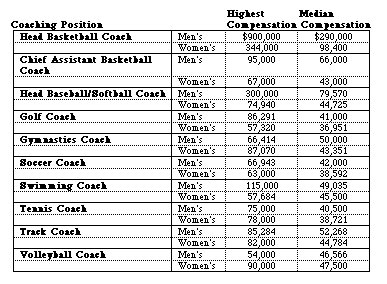
COACHES: Salaries for Division I-A Men's and
Women's Coaches (1996-1997)

Download Choice: Word Document;
PDF.
A Chronicle of Higher Education (March 1997) study on Division I-A institutions shows disparity between top coaches and the rest of the academe.
Women's Basketball Coaches Association Survey
(April 1995)
According to the WBCA, nearly three fourths of the coaches of Division
I women's basketball teams are female. 32% of women's coaches recieve more
than $60,000 but 88% of the coaches of men's teams earn more than $60,000.
In 1993-94, only 27% of the women's coaches made more than $60,000 but
73% of the men made more than $60,000. 9% of the female head basketball
coaches receive additional income from radio shows (compared to 48% of
the males) and 7% of the females receive additional income from television
shows (compared to 45% of the males).
UNIVERSITY OF IOWA: Select Men's Coaches
In a Des Moines Register article (4/12/95) entitled "Student's
desire for pay growing," the following salaries were reported:
Head Wrestling Coach - Dan Gable:
Gable's salary is $6,000 less than the top football assistants and $11,000 more than two of the basketball assistants.
Head Basketball Coach - Tom Davis
Head Football Coach - Hayden Fry
BIG 12 CONFERENCE: Menís and Womenís
Athletic Programs
The Chronicle of Higher Education collected data from the Big 12 athletic
conference to assess equity between the menís and womenís sports programs.
(1996-97)
Gender Equity Report; Published March 1997, Women's Sports Foundation
A National Womenís Sports Foundation evaluation (published in March 1997), responded to by 767 of 902 Division I, II, and III institutions, found that men held about three-fourths of the nationís full-time head and assistant coaching positions. Just 1.9 percent of the head coaches of menís teams were women, while 45 percent of the head coaches of womenís teams were men. In Division I-A, head coaches of womenís teams are paid $.63 for every dollar earned by head coaches of menís teams.
A National Womenís Sports Foundation evaluation (published in March 1997), responded to by 767 of 902 Division I, II, and III institutions, found that women comprise 53 percent of all undergraduate students but only 37 percent of all NCAA student-athletes.
Girls' participation hit another record level in 1997-98 at 2,570,333, an increase of 98,290 from the previous year. Girls' competitive spirit squads experienced the largest gain, up 23,584 participants. Soccer and fastpitch softball also registered significant increases, with participation up 20,051 and 19,767 individuals, respectively. Boys participation increased, as well, reaching 3,763,120 individuals--the greatest level for boys since 1977-78. Overall, athletic participation increased for the ninth consecutive year.
The following numbers regarding females competing on male teams are taken from the "High School Athletics Participation Survey" conducted by The National Federation of State High School Associations.
The National Collegiate Athletic Association - 2/16/94
Special Note: From 1991-92 to 1992-93, the NAIA dropped from 439 members to 411 members.
Women's Sports Foundation Participation Statistics Packet - August 1994
Figures derived from NAIA and NCAA Annual Reports, enrollment data
from U.S. Department of Education, National Center for Education Statistics,
Fall Enrollment in Colleges and Universities surveys and Integrated Postsecondary
Education Data System (IPEDS) surveys, August 1994.
*Projected.
Year Athletic % Enrollment Athletic % Enrollment
Participation Athl Participation Athl
MEN WOMEN
1981-82 230,047 7.1% 3,261,000 91,986 2.9% 3,188,000
1982-83 236,584 7.2% 3,299,000 110,232 3.5% 3,184,000
1983-84 242,134 7.3% 3,304,000 113,728 3.5% 3,210,000
1984-85 251,315 7.9% 3,195,000 121,634 3.9% 3,153,000
1985-86 248,744 7.9% 3,156,000 125,847 4.0% 3,163,000
1986-87 238,913 7.6% 3,146,000 121,675 3.8% 3,206,000
1987-88 229,358 7.2% 3,164,000 121,725 3.7% 3,299,000
1988-89 230,659 7.2% 3,206,000 124,189 3.6% 3,436,000
1989-90 225,480 6.9% 3,279,000 121,512 3.4% 3,562,000
1990-91 232,048 .0% 3,337,000 125,096 3.4% 3,640,000
1991-92 229,833 6.7% 3,436,000 118,446 3.1% 3,786,000
1992-93 227,040 6.6% 3,426,000 120,284 3.1% 3,822,000
1993-94 226,590 6.5% 3,468,000* 126,010 3.3% 3,806,000*
1994-95 222,077 6.4% 3,453,000* 129,376 3.4% 3,801,000*
Donna Shalala, Secretary of the Department of Health and Human Services, and the Womenís Basketball Coaches Association released a report at the 1997 Womenís Final Four on the benefits of physical education on the long-term health of women. The key recommendations and conclusions of the report include: